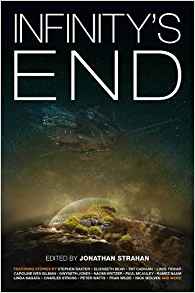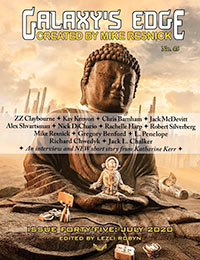Russell Letson Reviews Infinity’s End, Edited by Jonathan Strahan
 Infinity’s End, Jonathan Strahan, ed. (Solaris 978-1-78618-106-0, $14.99, 347 pp, tp) July 2018. Cover by Adam Tredowski.
Infinity’s End, Jonathan Strahan, ed. (Solaris 978-1-78618-106-0, $14.99, 347 pp, tp) July 2018. Cover by Adam Tredowski.
For seven years and six volumes, editor Jonathan Strahan has been devising a consistently strong original anthology series that has engineered, reached, met, and bridged infinity from the edge onward (or inward?), and even gone to war in it. Now, in the seventh and last of the Infinity Project anthologies, we have reached Infinity’s End. Each volume, per its title and the editor’s Introduction, has a loosely guiding theme (exploration and colonization, an industrialized solar system, “super-engineering projects,” future warfare), and for this one Strahan asked 14 writers for stories “to open up the solar system, to look again at its vastness, its incredible scale, and at how humanity in different ways might fit successfully and happily into its nooks and crannies.”
Right off it is clear that “humanity” can be a pretty elastic descriptor, and many of the stories feature humans of the distinctly post variety. For example, the protagonists and much of the rest of the cast of the first story, Justina Robson’s “Foxy and Tiggs”, are dramatically modified physically and considerably enhanced mentally. The resort-hotel security team of the title are embodied as, respectively, a fox and a velociraptor; the staff consists of all manner of real and imaginary creatures; and the hotel itself is a multi-planetary sentient being somehow present in and through all of them. The story line is not as exotic as the cast – it could be a light-entertainment TV detective show, from discovery of a body to wild chases through backstairs and tourist areas to head-faking plot-feints. Fun, though.
The protagonist of Nick Wolven’s “Cloudsong” is a diplomat tasked with negotiating a resource-access deal across increasingly exotic spaceborne splintered and specialized human subspecies out in the Kuiper Belt – Darklings, Visualizers, Aesthetics, Old Ones – and finally understanding the slow music of orbital mechanics. Lavie Tidhar’s “Talking to Ghosts at the Edge of the World” turns on a single adaptation: “nodes,” neural implants that function as mental enhancements and communication connections and that maintain a remnant of personality even after the biological brain is dead – a device that can be removed by a “spirit talker” for preservation or erasure. The most striking feature of the story, though, is the portrait of a solar system filled with the remnants of wars, “the military debris of centuries of sporadic fighting: sentient mines and boobie-trapped dead ships, mimic tech and… robots of all sorts,” including some “who abandoned war in search of higher truths, new converts to Buddhism or the Way of Robot…. Sentient mines discussing obscure philosophies on high-encryption channels.” It’s the shortest story in the volume, but this dense background left me wanting to see more of this world.
Speaking of stories that are, TARDIS-like, bigger on the inside than their length would suggest – in “Prophet of the Roads” Naomi Kritzer also evokes a whole, complex Before and suggests that there is an After leading out of this episode: once there was a war, and before that there was an AI-based (or enforced) community and peace across all humankind. The issues invoked in the Now of the present action are just the teensiest bit programmatic, but this is another setting one would like to see more of. Seanan McGuire’s “Swear Not by the Moon” is so concentrated that the mass of back-story and authorial commentary (“At the dawn of the twenty-first century, the newest incarnation of robber barons and oligarchs stood tall”) almost overbalances its present action. In fact, I suspect that the real story is that background: the idea of a privately-owned Titan transformed into an amusement park, with a Woman Who Bought a Moon vibe.
Other stories feature humans adapted or transformed almost to the point of leaving the species altogether. The artists and touristic ramblers in the “Adaptasporic Realm” in Alastair Reynolds’s “Death’s Door” don bodies adapted to extreme environments – Titan, Venus, Jupiter – as easily as we put on down jackets or rubber wellies. Two other stories go all the way to the outer fringes of a Stapledonian scenario. Peter Watts’s “Kindred” is one side of a conversation between a strange collective being (“a few cubic AUs of thinking smog”) and “Phil,” a resurrected personality who is very likely who I suspect he is. (There are clues, but I’m not giving them away.) It’s immanentized-eschaton territory and pretty philosophical, as well as playful in a dead-serious way.
The cast of Hannu Rajaniemi’s “A Portrait of Salai” is equally post-human, though rather more conventionally physical in form. The protagonist, Sfumato, is a collective intelligence
spread out [across] nearly a thousand vessels. There were von Neumanns that had gnawed Mercury and Venus, apple-sized, self-replicating machines. There were ancient ships that had been Sfumato since the beginning… even a magnetoform, a piece of living solar wind, that had once swum in the heart of the Sun….
As in “Death’s Door”, the final challenge of sapient existence would seem to be boredom. Sfumato faces the threat posed by the Iron Critics of the Pageant, “an attempt to evolve a truly benevolent superintelligence” whose curiosity and mania for novelty (in a universe where nothing is new) results in the disassembly of whatever attracts its attention.
Before such ennui sets in, though, and while reasonably standard human bodies and sensibilities apply, the siren song of extreme exploration remains strong. In Stephen Baxter’s “Last Small Step”, in defiance of humankind’s general and officially-enforced withdrawal from that outward urge, a few stubborn souls still seek to be the first to visit some distant object, and a few enforcers get the job of hauling them back to the home fires. Fran Wilde’s “The Synchronist” recalls the 18th-century competition to devise a way of measuring latitude at sea, with timekeeping being the key to safe and profitable interstellar travel. The tale is told, despite its title, somewhat out of sequence and from two viewpoints, for good reason.
Also among the merely (if exceptionally able) human is Kristine Kathryn Rusch’s protagonist in “Once on the Blue Moon”: a plucky, rebellious, brilliant 11-year-old girl right out of a Heinlein juvenile who takes on a gang of space pirates out in the boonies of a libertarian-flavored solar system. Paul McAuley’s “Nothing Ever Happens on Oberon”, set in his Quiet War future, puts a young woman working on a moon of Uranus in a similar situation, dealing with a mysterious castaway with connections to that long-ago, but not at all forgotten conflict – and pushes at the edges of the trope to show what happens in the rest of the life of a plucky, rebellious, etc. young person.
Closer to home, even if “home” is a wandering space habitat, Kelly Robson’s “Intervention” covers the geriatric end of the scale with a protagonist looking at the end of a career of raising children. The story also manages to sketch in the outlines of its political-social world – a settled and varied solar system, a mix of planetary and habitat-based living, a Luna that sounds like a Randian dream gone nightmare – with great economy and without a single infodump. Linda Nagata’s “Longing for Earth” is set in a farther-future extensively-settled and re-engineered solar system filled with “biome worlds,” but this time the featured trope is uploaded versus embodied life (the Virtual and Tangible Layers), which interacts interestingly with the protagonist’s fascination with and appreciation of the “verisimilitude” of the recreated terrestrial environments whose originals he can never experience in person.
Infinity’s End offers not just an anthology of stories but a set of contemporary treatments of perennial science-fictional tropes, ideas, schticks, and tapdances. The next time somebody suggests that SF has run out of material, has become a museum genre, or, worse yet, is decadent, I’ll suggest a look at this book and its companion volumes. They are not the only evidence to the contrary available, but they are solid and absolutely contemporary examples of what the genre can still do.
Russell Letson, Contributing Editor, is a not-quite-retired freelance writer living in St. Cloud, Minnesota. He has been loitering around the SF world since childhood and been writing about it since his long-ago grad school days. In between, he published a good bit of business-technology and music journalism. He is still working on a book about Hawaiian slack key guitar.
This review and more like it in the September 2018 issue of Locus.
 While you are here, please take a moment to support Locus with a one-time or recurring donation. We rely on reader donations to keep the magazine and site going, and would like to keep the site paywall free, but WE NEED YOUR FINANCIAL SUPPORT to continue quality coverage of the science fiction and fantasy field.
While you are here, please take a moment to support Locus with a one-time or recurring donation. We rely on reader donations to keep the magazine and site going, and would like to keep the site paywall free, but WE NEED YOUR FINANCIAL SUPPORT to continue quality coverage of the science fiction and fantasy field.








